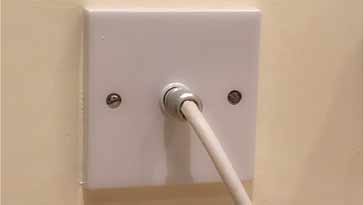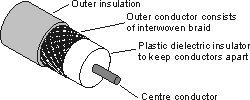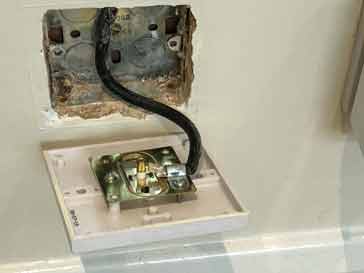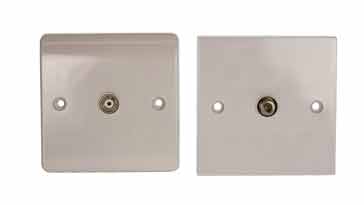How to Wire a TV Antenna (Aerial) Socket
Many televisions use an antenna socket on the wall and it is normally easy to wire in a new socket or cable to provide a neat and useful job.
Home » Antennas & Propagation » this page
TV antennas guides include:
Types of TV antenna
Buying a TV antenna
TV antenna direction alignment & pointing
TV transmitter finder app
TV antenna alignment meter
Buying TV antenna amplifier / booster
Indoor TV antenna & set-up
Satellite TV dish installation
How to wire a TV antenna socket
Why doesn't a TV antenna work any more
General antenna installation guides
Antenna installation guide
Attic installation
Antenna height
There may be occasions where it is necessary to wire in a new TV antenna or aerial socket, or even provide a complete new TV aerial socket installation.
Using a TV wall socket enables the coax down-lead from the antenna to be terminated in the socket, and then a short lead can be taken to the TV set.

In this way, if changes are made in the room, it is easy to change the lead from the socket to the TV rather than having excess coax in the room in case changes need to be made.
Having a TV aerial socket installation can often be very beneficial, and connecting the antenna coax cable needs to be undertaken with care for the best and most reliable results.
TV antenna cable socket requirements
The TV antenna sockets often come as a "wallplate" and in appearance they are very similar to the power line or mains sockets seen within most rooms these days.
Approaches taken for wall mounted power sockets will vary from country to country, so it will be necessary to follow the approaches taken in your particular country.
To enable the socket to fit the wall, often (certainly in the UK and very many other countries) a metal box is sunk into the wall and the wires run within the wall, behind plasterboard of the wall is not solid and the wires appear in the metal box.
When selecting the TV antenna socket for installation, it is necessary to make sure that t has the right socket style for the plugs that will be used. Occasionally Belling Lee types may be osed or there can be the Type F connectors that are far more widely used these days. Either way, the right connectortype must be used.
How to wire the TV antenna / aerial socket
Installing a TV socket and wiring it up is quite straightforward, although it may be a little fiddly sometimes.
Warning: If you are in any doubt as to how to proceed, then it might be best to seek professional help. Although there should not be high voltages present, it is always necessary to proceed with caution. Under no circumstances should the antenna socket be combined with any power line or mains wiring.
Additionally, this work should not be undertaken when any electrical storms are expected. Even though a direct strike may be unlikely (but always possible), the induced voltages from lighting strikes in the vicinity can still be quite high.
When preparing to wire up the TV antenna socket, it is first necessary to get everything prepared.
The tools required will be a wire cutter and something to slit the outer of the coax cable back to expose the required conductors. It will also be needed to strip back the internal dielectric insulation.
A wire cutter to trim any excess braid may also be needed. Finally a screwdriver is needed. Typically this will be an electrical type that can tighten the size of screws used in the wall socket.
It is also worth understanding how a coax cable is constructed. It consists of an inner conductor surrounded by a layer of insulation also called a dielectric and then a conductive woven copper braid which acts as a screen. The outer layer is then a protective insulating sheath.

Having prepared the tools and understood the make-up of the coax cable, the next stage is to prepare the socket area.
It may be that a new socket and the appropriate back box has been sunk into the wall and is ready. Any loose plaster and dust should be removed so that it does not come out later, or interfere with the connection of the cable.
Normally the cable will be installed within the wall, so it may be that there is little movement within the wall. Only a small length will be able to be contained within the box.

Accordingly care is required to ensure that the correct length is available - not too short otherwise it con't be possible to connect it, and not too long otherwise it won't be possible to contain it within the box when it is connected and the socket panel screwed back onto the wall.
TV antenna wall sockets are available from many manufacturers and therefore lengths and to soem degree, the process may require to be tailored to the particular TV antenna wall socket in question. However the differences are likely to be relatively small.
The installation can be undertaken in a number of easy stages:
Cut back the outer sheath: Carefully slit the outer of the coax cable sheath and peel it back to the required length for the socket. Be careful not to cut through the braid or the dielectric insulator. This will expose the braid screen directly underneath. Normally it will be necessary to cut back approximately 2 cm or ¾ inch.
Roll back braid: The next stage is to roll back the braid screen over the top of the outer sheath. This will fit under the clamp fr the brad on the socket.
Cut away dielectric to expose centre conductor: Once the braid has been rolled back it will be possible to see the spacing dielectric insulator between the inner and outer conductors. This can be cut away to reveal the inner conductor. Cut through the dielectric around 5mm or 1/5th of an inch away from the beginning of the PVC sheath over which the braid has been folded back. Then remove the dielectric insulator to reveal the the centre conductor of the coaxial cable.
The length of dielectric remaining and the length of the centre conductor will be such that the outer can be clamped and the inner conductor connected to the screw terminal provided for it.
Connect conductors: With the coax cable cut to length, the outer of the cable can be clamped using the larger clamp for the overall cable, and the inner can be connected tot he screw terminal provided for it. Both connections should be firmly made, but not over-tightened so that anything becomes damaged.
Fit socket plate in position: With the cable connected, the overall socket plate can be returned to the wall fitting to make a neat overall connection. It is possible that a short length of cable can be contained within the box under the socket plate, or even pushed back into the wall if this is possible. Only a short length of cable can be contained behind the socket itself.
The wall plate can then be fitted in its final position and the screws can be tightened up to make a neat job. All that remains is for the cable connecting this wall plate socket to the television itself.
Warning: It is necessary to be very careful not to let the braid from the outer conductor short to the inner conductor. As there are very many fine wires making up the braid, it is easy for a stray one to cause a short. It is well worth carefully inspecting the assembly once everything has been put together to ensure there is no possibility of a short.

Overall, wiring a television cable socket into a wall fitted socket is quite easy and if the relevant coax cable and back box are already available, the job should not take very long.
Smaller sockets
In smem instances, smaller sockets may be used. Thse can be used where a coax cable comes in through a window or wall and the cable is free. This type of smaller fixed socket can be used to provide a more stable solution and not have the television plugged directly in to the downlead.
This again can provide a neater solution than having a long free cable where excess cable may need to be coiled neatly away.
These fixed TV cable sockets are wired in the same way as the wall mounted ones. The only difference is that the socket is much smaller, but it is likely that the access will be beter and the wiring will be easier to accomplish.
These sockets tend to be used where an existing cable comes into the house and a neater termination is required than what might already be there. Often the ones where the TV coax cable is buried in the wall are much neater, but this other type can be used where necessary.
Assembling a TV aerial wall socket is quite straightforward and can be undertaken by most people. With a little care and an awareness of general electrical safety, the job can be quite easy to undertake.
Having a TV antenna socket as a "wallplate" similar to the power line or mains sockets on the wall makes a much neater job than having a coil of wire running behind te TV set because you don't want to cut the cable short.
 Written by Ian Poole .
Written by Ian Poole .
Experienced electronics engineer and author.
More Antenna & Propagation Topics:
EM waves
Radio propagation
Ionospheric propagation
Ground wave
Meteor scatter
Tropospheric propagation
Antenna basics
Cubical quad
Dipole
Discone
Ferrite rod
Log periodic antenna
Parabolic reflector antenna
Phased array antennas
Vertical antennas
Yagi
Antenna grounding
Installation guidelines
TV antennas
Coax cable
Waveguide
VSWR
Antenna baluns
MIMO
Return to Antennas & Propagation menu . . .


